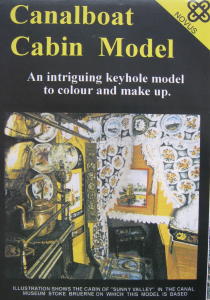 General Information
General Information
Author:
Lutz Pietschker
Version: 2010-12-31
Paper Modelling | Home Page | Links | What's New
 General Information
General Information
This nice little model is based on the boat "Sunny Valley" that is (or used to be) on display in the Canal Museum in Stoke Bruerne, England. It shows the cabin of a narrowboat "butty", i.e. an unpowered boat that would be towed by a horse, an engine-powered narrowboat or a tug. The boatman and his family lived in this cabin for the most part of their working lives, and you can see that they tried to make themselves a cosy home. The model is aptly called a "keyhole model" because it shows only the cabin interior, and only as much as can be seen through the door/hatch opening at the stern of the boat. Well, as you can see below I did not have the heart to hide all the interior, so I changed the design a bit to make the keyhole larger. This was only one of the things I "supered", for more information about the changes I applied see the Building Hints section, below.
I picked the model up when visiting Britain, sometime in the late 1990s, I believe; maybe it was in the small Canal Museum in London, near Regent's Canal, I am not sure.
Here is an impression of what the actual cabin looks like (image taken from the cover of the model kit):
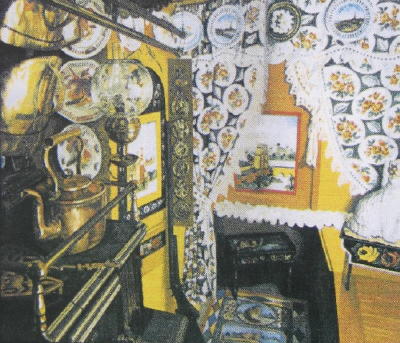
and here is a photo of the actual boat (reduced image from the excellent Blisworth image site), unfortunately with closed cabin doors:
Sunny Valley is one of the famous "Barlow Boats", and she was registered at Daventry which is near the Grand Junction Canal but, curiously, has no direct access to any canal; a connection was planned but never actually built.
Since some of my work would no longer be visible (or at least hard to photograph) once the model was assembled, I include some "construction progress" images.
(Click image to show it in large size in a new window.)

|
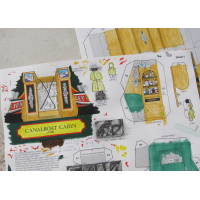
|
My holiday modelling shop, set up on the terrace. To the right a close-up of an intermediate stage of colouring the model. |
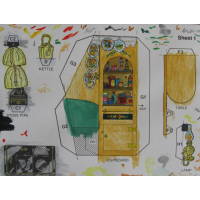
|
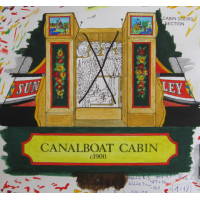
|
Some brassware and the kitchen cupboard. The right picture shows the cabin door insides and something like a perspective view of the boat's afterdeck. Compare this to the photo of the boat, above, and you will see what the designer tried to show. |
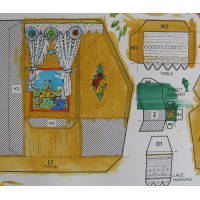
|
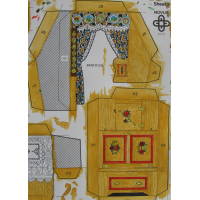
|
The cabin end wall, adjacent to the cargo space; there is no window except, I presume, the little lozenge-shaped one– the frame below definitely is no window but a piece of art, in the "castle-and-roses" style the boats are famous for. To the right the partition wall that is between the kitchen and the living room and wardrobe The complete compartment is about 2 by 3 metres in the original boat, just the size of a very modest caravan. For many boat people it was all they had as a home. |
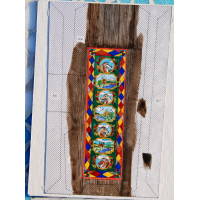
|
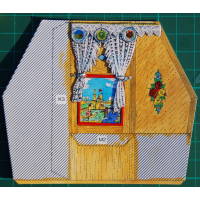
|
The floor of the cabin. This took some time to paint.
To the right, the "supered" end wall with picture frame, curtains and decorative plates. |

|
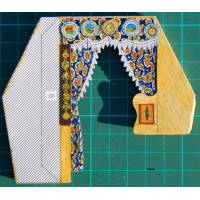
|
Other interior parts: The cupboard and the partition wall, the latter also with curtains, plates and "bright bits", as the boatmen called the brasses that were attached to horses' harnesses. |
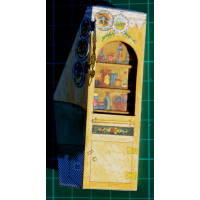
|
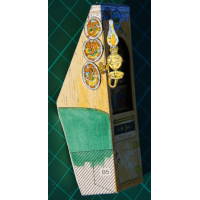
|
Two views of the cupboard. I modified the originally flat view of the interior a bit to make it look more convincing. At the side of the cupboard: More plates and an oil lamp. The lamp used to be one of the most prized possessions of the boatpeople. |
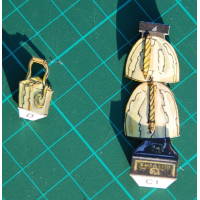
|
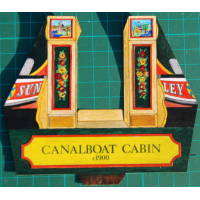
|
More brassware: The kettle and the guards for the stovepipe. The boatmen were proud to keep the boat clean and the brass shining in spite of the dirty loads like coal they often carried. I doubled the kettle spout and attached handles to the stovepipe guards.
Again the view of the door. By now, the picture and plate frames have been improved. |
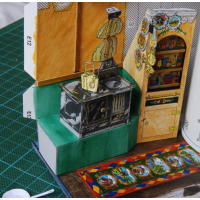
|
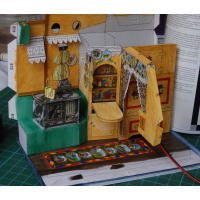
|
Two views of the cabin interior before the lid closes on it. Note the wooden ledgers on the side walls and cabin roof. The bunk that runs all the length of the cabin is still missing. |
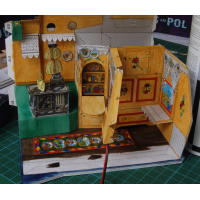
|
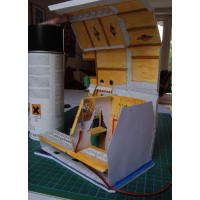
|
The end wall has been added. The roof is supposed to fold around the completed interior, a design I thought a bit risky, but it worked very well. |
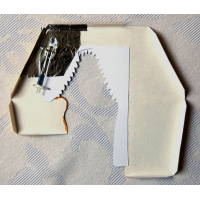
|
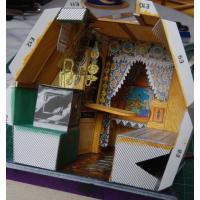
|
You could already see it on the previous image: The lighting for the front part of the cabin, attached to the reverse side of the partition wall. I thought it a shame that no-one would be able to see it properly later on, so I added an LED to light the cabin.
The other picture shows the completed cabin, just the door wall is missing. |
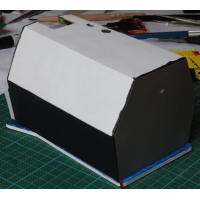
|
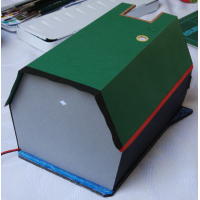
|
The original model made no provisions for a pretty exterior, so I planked the cabin with black and green paper from the outside and added a red stripe to hide the joint. The end wall got a gray outside liner- this wall would be seen from inside the cargo hold. Some boats had a door from the cabin to the cargo hold, but the end wall of this model does not look like it had a door. The wavy black border of the green roof is meant to represent the missing cargo space cover (though that would actually be higher and more tent-like, and covered with tarpaulins). |
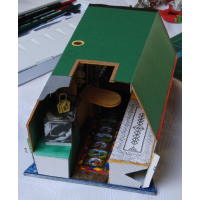
|
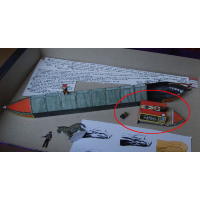
|
This is the way it looks from the door side now.
The image to the right shows a different model but nicely illustrates where the cabin would be on the boat, and how small it was compared with the complete boat. The boat was typically 2.1 metres wide and up to 20 metres long. The maximum size was determined by the locks it would need to pass. |
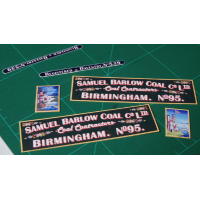
|

|
Having added some parts to the outside already I thought I might as well add the license and owner's plates and the other paintings found on the original boat. I re-created these, based on photos of the original boat, using Adobe Illustrator.
And this is the complete model. Voila! |
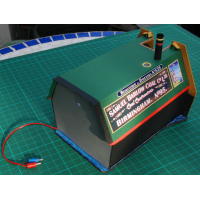
|
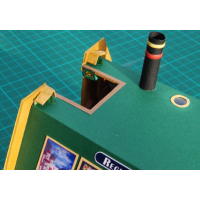
|
The model from the rear, showing the flex that leads to the LED.
The the right, a detail of the door wall. I did not like the thought that it would enshrine the cabin completely, so I made it foldable. You can see the cardboard clips that hold the wall in place. The smoke stack was also added by me. The brass ring is part of a small, clear window in the roof. Unfortunately, it is too small to see much through it, and that it is a window is an assumption of mine, it may well have been an air vent (both vents and skylight windows were common in those boats). |
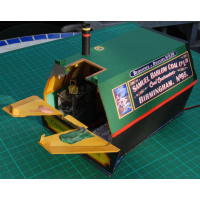
|
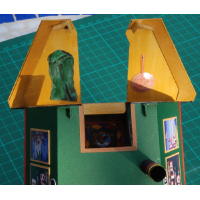
|
The wall folded away. The copper pan and the boatsman's jacket were my additions. |
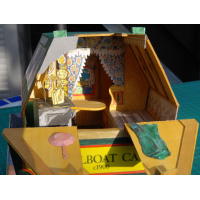
|
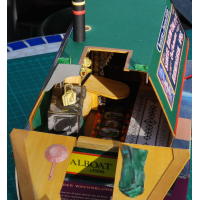
|
And again, a look into the cabin on a clear, sunny day as you have them so often in England's coal districts... ok, joking, but it must have been great moments for the boat people when the sun did actually shine like this. |
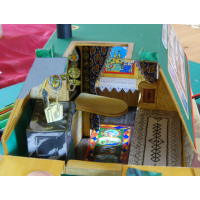
|
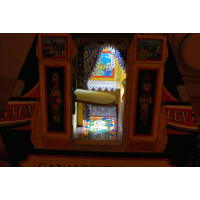
|
As dusk falls, the boat people light their cabin. And when it is dark outside the light from the cosy cabin can be seen from the quay where they spend the night. |
As a paper model, this one is easy: Just 4 sheets, 20 parts, none of them complicated. The parts, or most of them, fitted well, just some of the lace hangings are a bit too wide to fit between the walls. However, the model comes in black and white print only, it is up to the modeller to colour it, and this is quite a task if you are not an artist. I am not, but I did my best to do the model whatever justice I was able to. And to be sure, I seldom had so much fun with a paper model. I only had aquarell colours when I built the model, and of course I had some trouble with paper warping. While building the model I decided to add other improvement, notably
Web Links: Wikipedia entry "Narrowboat" (includes further links), Glossary of narrowboating terms, Jim Payler's albums of canal boats, (including the Barlow boats images), the Sunny Valley legging experiment (for those of you who like the book "Hornblower and the Atropos" by C. S. Forester, where the first chapter describes a narrowboat journey, including a legging experience in the now-defunct Sapperton tunnel), the Horseboating Society (UK), narrowboat decoration images, humoristic view on narrowboats on Uncyclopedia
Books: I do not have many books about narrowboats, the books listed below just happened to come my way:
The Wikipedia page gives very good information, and the links in section above provide further information. Among the considerable group of enthusiasts the canal boat tradition is very much alive in Britain, and you will find a lot of information in books and on the Web. I can not add much to that, except my consternation that no decent paper models of narrowboats seem to exist, at least I was not able to find any; one or two very simple models exist that would be suitable for children to build. Even the cabin models described here seems to be out of print now, I did not find a trace on the Web.
As the author of this page I take no expressed or implied responsibility for the content of external links; opinions expressed on such pages are not necessarily mine. The web space provider is not responsible for the contents of this page or any linked pages.
Written and published by Lutz Pietschker. Please send comments about technical problems to the
site master.
-Made with a Mac!-
, last change 2011-03-12